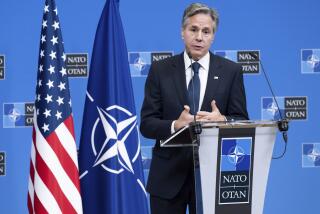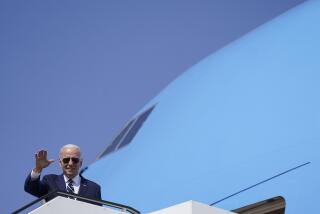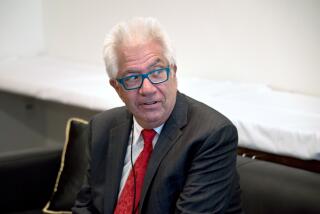U.S. Needs to Be ‘Omnidirectional’
- Share via
In recent years it has become fashionable in foreign policy circles to discern the end of the Eurocentric focus of America’s external interests. Prominent scholars and analysts have heralded the rise of the Asia-Pacific region to the top of the foreign policy totem pole. Writing in the September issue of Foreign Affairs, Kishore Mahbubani, the head of Malaysia’s foreign affairs ministry, exulted that the Asia-Pacific had become the “hinge of history.”
In diplomacy, as in other walks of life, hype is a dangerous business. Today it is particularly misplaced, given that recent developments have raised serious doubts about the claims of Asia-Pacific predominance. Malaysian and other Southeast Asian stock and currency markets have experienced wild gyrations in response to fears that the economic miracle there may be running out of steam. Over the summer, the Thai economy hit a roadblock and had to be rescued by the International Monetary Fund. In South Korea, the liquidity of leading banks is causing concern to the New York rating agencies. In China--despite its huge potential--U.S. firms have found profits hard to come by.
Larger ethical, societal and cultural questions have also surfaced. Yakuza gangsters have infiltrated Japan’s financial system, forcing leading brokerage houses to suspend operations. South Korea’s December presidential elections are adrift in an ocean of sleaze in the wake of allegations that the ruling party candidate’s two sons received preferential exemption from military service. The Asian Development Bank has reported that East Asia is the “world’s most polluted and environmentally degraded region.” On the cultural front, Asia’s indigenous architectural heritage has been--and continues to be--mindlessly sacrificed on the altar of high-rise development.
Alongside these indications that the easy money boom in the Asia-Pacific is over, U.S. relations in the region appear headed for difficult times. The punitive fines announced Sept. 4 against Japanese shipping interests signal a new round of trade tensions. U.S. firms are gearing up for battles on aviation, automotive, financial and telecommunication issues. “The numbers are moving in the wrong direction” is a typical comment from the U.S. automobile industry. During Chinese President Jiang Zemin’s visit to Washington next month the number of contentious issues--China’s burgeoning trade surplus among the more prominent--will comfortably exceed those on which agreement exists.
Having suffered an unappetizing diet of propaganda trumpeting the superiority of Asian business methods and social mores, many Americans now may feel the temptation to gloat. Some may conclude that the U.S. should shift its Asian priorities southward and westward where there are plenty of potential areas for profit. The huge energy reserves of the Caspian and Turkmen regions, for example, beckon enticingly. In South Asia, the computer-based service industry between the U.S. and India is growing exponentially.
This would not be good policy. The fact that the hype about a limitless Asia-Pacific El Dorado was wrong does not mean that the U.S. should relegate the region to the back burner. Significant U.S. investments remain at stake. Asian uncertainties, for example, have contributed significantly to the recent sharp decline in the stock prices of several major U.S. manufacturers.
More positively, the Asian downturn has had a sobering effect. It has moderated irritants like the unproductive debate on Asian values. Whereas two years ago bestseller books in China and Japan were about saying “no” to America, today a more responsive attitude prevails. Last month, for example, Japan agreed to take on new naval tasks that will materially assist U.S. power in Asia. During his recent visit to China, Japanese Prime Minister Ryutaro Hashimoto gave no ground in the face of Chinese protests. Indeed, the Chinese protests had a ritualistic flavor, reflecting China’s own tacit recognition of the need to keep in the U.S.’ good books.
These new circumstances brighten prospects for a resolution of the areas of economic contention on terms favorable to the U.S. They also expand America’s freedom of maneuver on the more complex issues like Taiwan and North Korea. To take full advantage of this propitious moment, however, the U.S. must not let its attention wander. Asia policy must be a year-round activity in the White House, not just dusted off at the annual Asia Pacific Economic Cooperation jamboree.
Gen. Charles de Gaulle designed French foreign policy to be “omnidirectional.” For better or worse, the U.S. must do the same. Centricity, whether Euro, Asian or some other hue, is not an option. As for hinges of history, the less said the better.
More to Read
Sign up for Essential California
The most important California stories and recommendations in your inbox every morning.
You may occasionally receive promotional content from the Los Angeles Times.













